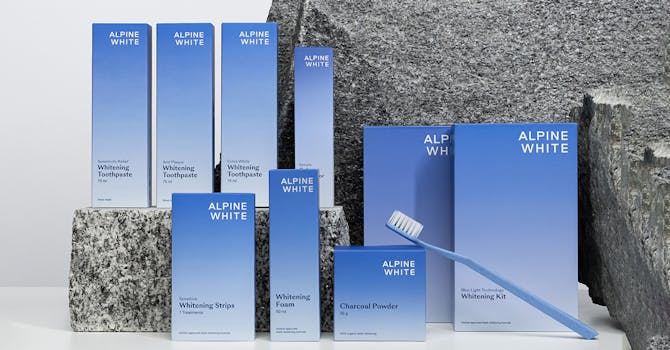Revealing toothpaste statistics: usage, market dynamics, and consumer trends
At ALPINE WHITE, we've looked closely at how different toothpastes work to keep your teeth and gums healthy. We care about giving you the best options for your oral care. In this article, we share our findings and top toothpaste statistics to help you understand which toothpaste might be best for you. We've done all the hard work of testing and research so you can easily choose what's right for your smile.

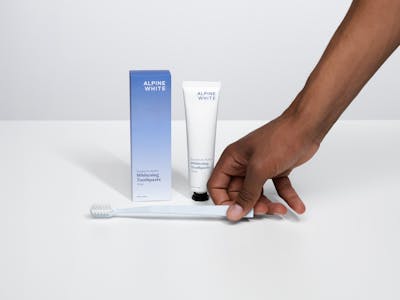
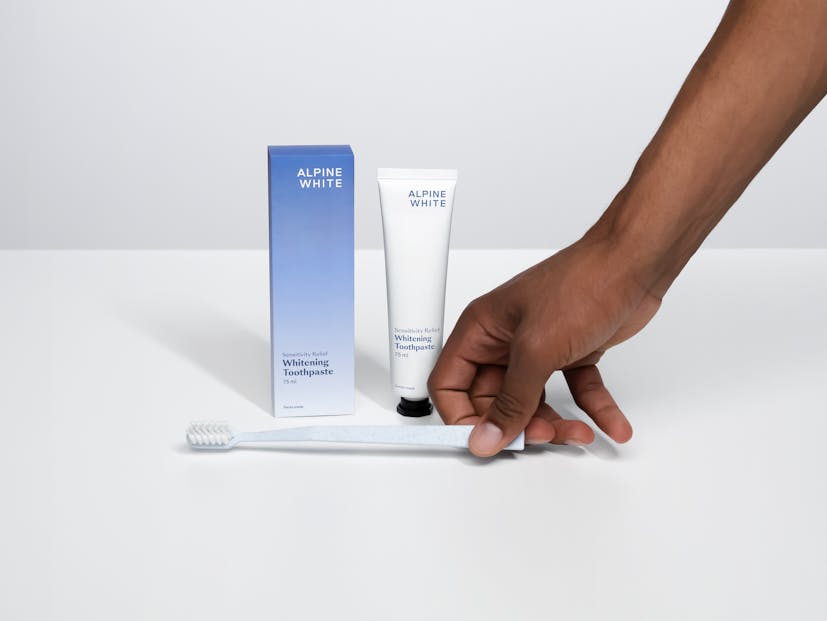
Toothpaste statistics key takeaways
- The toothpaste market is projected to grow from $34.48 billion in 2024 to $50.78 billion by 2029, with an annual growth rate of 8.05%.6
- The worldwide toothpaste market is expected to grow to $18.3 billion in 2025.2
- In 2020, 307.17 million people in the U.S. used toothpaste. This number is expected to rise to 316.03 million by 2024.1
- Over 35% of people worldwide experiencing tooth sensitivity have increased the need for toothpaste containing potassium nitrate.2
- In 2021, Procter & Gamble was the top toothpaste seller in the U.S., making over $1 billion.3
- In 2022, sales of toothpaste in the U.S. from stores reached about $3.36 billion.9

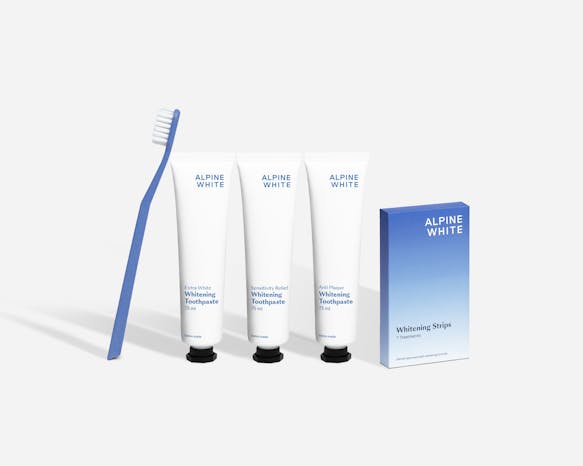
The perfect Care Routine with whitening effect. The Care Routine combines our three Toothpastes, so you can find your perfect Toothpaste for daily care, the Whitening Strips for bright teeth and our Toothbrush.
- Whiter teeth with the strips after 3 days
- Lasting result with the Toothpaste
- Perfect combination of whitening and care
Toothpaste usage statistics
Every day, millions of people use toothpaste to clean their teeth, making it a common yet essential part of our health routine. Its widespread use highlights not just the importance of oral hygiene but also the variety of choices available, catering to different needs and preferences around the globe.
- In 2020, over 71 million Americans brushed their teeth with toothpaste at least 4 times a day on average.4
- A study found that people in Costa Rica used an average of 466 grams of toothpaste each, and in Brazil, they used about 456 grams per person.12
- In 2020, about 139.37 million people in the U.S. used Colgate.5
- In 2020, about 17.64 million people in Great Britain preferred whitening toothpastes, making them the top choice. Also, around 16.2 million people chose regular toothpastes.7
A study in Karger aimed to explore how much toothpaste preschool children use and swallow. It measured the amount of toothpaste eaten by subtracting the amount spat out from the total amount used.8
This is what they found:
- On average, for 66% of the people, the amount of toothpaste used each time they brushed their teeth differed by less than 0.250 grams.8
- For 69% of the kids, the amount of toothpaste they accidentally swallowed each time was less than 0.100 grams.8
- Also, when comparing the three different times they brushed their teeth, there was no big difference in how much toothpaste was used or swallowed.8
- A study in Science Direct wanted to see how much toothpaste French families use and how it affects them, letting them use their usual toothpaste at home as they normally would.15
undefinedundefinedundefined
As people get older, they tend to use toothpaste more often and use more of it each time. But, their exposure to toothpaste decreases as they age.15
- Kids between 2 to 6 years old were the ones who used toothpaste the most, with a top exposure level of 8.2 milligrams per kilogram of their body weight each day.15
- The exposure level for adults was 2.8 milligrams per kilogram of body weight per day.15
Every day, we all use toothpaste, showing how much we care about keeping our teeth clean and healthy. There's a huge variety out there, and how much or often we use it really depends on the person.
In the middle of all this, there's ALPINE WHITE's Whitening Toothpaste. We’re proud to say our toothpaste, made in Switzerland, is all about giving you a whiter smile safely, without damaging your enamel. It's our way of making sure you get what you need from a toothpaste, keeping it straightforward and effective.
Toothpaste market statistics
The toothpaste market, selling billions of tubes yearly, combines science and flavour. It's essential for daily hygiene, offering a wide range for every preference.
- The toothpaste market is projected to grow from $34.48 billion in 2024 to $50.78 billion by 2029, with an annual growth rate of 8.05%.6
- The worldwide toothpaste market is expected to grow to $18.3 billion by 2025. This is because more people are becoming aware of the importance of oral hygiene, there are more people in the world, and new kinds of toothpaste that are reasonably priced are being introduced.2
Market trends show that due to the risk of dental fluorosis in young kids, there's more demand for fluoride-free toothpaste.2
- Over 35% of people worldwide experiencing tooth sensitivity have increased the need for toothpaste containing potassium nitrate. There's also a higher interest in keeping teeth perfectly white, leading to the popularity of tartar control and whitening toothpastes.2
- Additionally, after negative reports about triclosan and its ban in soaps by the FDA, there's a growing preference for toothpaste without triclosan.2
- In 2022, sales of toothpaste in the U.S. from stores reached about $3.36 billion.9
- In a study by Scholink on how much was sold in U.S. stores in 2007 and 2008. It covers the total money made and items sold, as well as sales without discounts and sales with discounts.10
undefinedundefined
The findings reveal five groups, but there are only four groups based on price and quality. The high-end group is split into two smaller groups.10
- Crest, the top brand, controlled 34.7% of the market and belongs to the middle-price group, costing $2.99. This is a bit more expensive than Colgate, the second-place brand, which also falls in the middle-price group and costs $2.86.10
- In 2008, on average, 37.2% of the toothpaste sold was through promotional sales.10
- Colgate is the only brand in the "Very Heavy" group with 47.9%. Crest and Aquafresh are both in the "Heavy" group, with Crest at 38.9% and Aquafresh at 38%.10
- Aquafresh targeted the budget market with low prices and, despite its leading 7.1% market share, felt it also needed to offer big discounts to maintain its position.10
Schloink discovered four main groups of competitors in the market, and here's how they stood based on their share of the market:
- The top company was Procter & Gamble Co., with their product Crest holding 34.7% of the market.10
- In second place was Colgate Palmolive Co., with Colgate having 33.5% and Ultrabrite at 0.5%.10
- The middle group included companies like Glaxo-SmithKline, with products Aquafresh (7.1%) and Sensodyne (6.8%), and Church & Dwight, with Arm & Hammer (5.2%) and Aim (0.7%).10
- The smaller players were Tom’s of Maine at 1.7% and Unilever with Mentadent (1.1%), Close-Up (0.6%), and Pepsodent (0.4%).10
- P&G is a top company worldwide that sells consumer products. In 2018, it made $67 billion in sales. Crest, a brand under its Health Care category, contributed to 13% of these sales.10
- Colgate Palmolive is a big company that makes products for everyday use. In 2018, it sold products worth $15.5 billion all over the world. Colgate toothpaste comes from its Oral Care Division.10
- Glaxo SmithKline is a large British company that sells medicines and had sales of $33 billion in 2018.10
- In 2018, Church & Dwight made $4.1 billion from selling products like Arm & Hammer toothpaste. They bought Aim toothpaste in 2003, which was popular in 1996 with a 7% market share due to its gel formula. By 2008, Aim's market share dropped to 0.7%, and they weren't selling the gel toothpaste anymore.10
- Tom’s of Maine started in 1970, created by Tom and Kate Chappell. It's well-known for making toothpaste from natural ingredients. In 2018, made about $76 million in sales.10
- Unilever, a large UK and Netherlands-based company, made $73 billion in 2017. When comparing their toothpaste brands' popularity in 2008 to 1996, Scholink found big drops for two brands: Close-Up fell from 6% to 0.6%, and Pepsodent from 2% to 0.4%.10
The toothpaste market is on the move, with more people looking for options that match their health concerns and lifestyle choices. It's not just about fresh breath anymore; people are choosing toothpaste for sensitive teeth, without fluoride, or with ingredients for whiter teeth. Brands like Crest and Colgate are keeping up by offering a variety of products. This shift shows that people are thinking more about what's in their toothpaste and how it affects their health. Companies are responding by creating toothpastes that cater to these personal preferences, making sure there's something for everyone.
Colgate-Palmolive Co (CL.N), CEO Noel Wallace said in 2022 at an industry conference that “the household goods maker sees its new Optic White Pro Series toothpaste as the type of premium product "vital" to its ability to raise prices, which will help drive profit growth this year.”
His comments were made at a time when many companies that sell consumer products are raising their prices as high as possible to make up for their own increasing costs.
Toothpaste statistics by country
Toothpaste use around the world can show us how different countries brush up on dental care. Some places might favor natural ingredients, while others go for strong whitening formulas. The cost of toothpaste can also tell us what people can afford or prefer to spend on dental hygiene. By looking at these habits, we can get an insight into global health trends and personal care priorities.
- Asia-Pacific, including China, is a key market due to a good economic climate, improved living standards, a move from homemade to commercial toothpaste, a preference for high-end toothpaste packaging, increasing health consciousness leading to more demand for organic toothpaste, and a big opportunity in populous countries like India and China.2
- The total toothpaste sales in the U.S. for 2021 were roughly $3.19 billion.3
- A study according to Scielo looked into how kids from rural parts of Caruaru, a city in Northeast Brazil, take care of their teeth, use dental services, and think about their own oral health.11
undefinedundefinedundefinedundefined - People in Costa Rica used an average of 466 grams of toothpaste each in 2017.12
- In Brazil, they used about 456 grams per person.12
- In 2011 and 2012, toothpaste sold in drugstores in the US made $517.2 million. The total money made from toothpaste sales in the US was around $1.6 billion during the same period.13
- In 2022, Chile and Peru were the top countries in Latin America to bring in products for dental and oral care.14
- Chile imported products worth 65 million U.S. dollars, while Peru's imports were valued at $52 million dollars.14
Fluoride toothpaste, which helps prevent tooth decay, was recently added to the World Health Organization's list of must-have medicines. However, it's not clear how affordable it is worldwide. A study looked at the cost of fluoride toothpaste in as many countries as possible, comparing prices in rich, middle-income, and poor countries.16
- In the study, 56% of the countries looked at were low or middle-income, while 44% were wealthy countries. Information on how affordable fertility treatments were was gathered for almost 40% of the countries that are part of the World Health Organization.16
- In the countries looked at, on average, a government worker with the lowest pay and no special skills had to work more than a day to buy 182.5 grams of the most affordable fluoride toothpaste from the top three best-sellers. This cost is higher than what is considered affordable.16
- The lowest point of the FTAR 95% confidence interval was under the limit, while the highest point was over the limit. This shows that the cost of fluoride toothpaste varied in the different countries studied.16
- 22 out of 78 countries found that buying the yearly recommended amount of the least expensive (top-three selling) fluoride toothpaste would be too expensive.16
- In wealthy countries, the lowest-paid workers could buy popular fluoride toothpaste with less than a fifth of a day's work, the quickest among different income levels.16
- In upper middle-income countries, the lowest-paid government worker typically needed to work around 0.72 days to afford 182.5g of the cheapest best-selling fluoride toothpaste.16
- In some countries where people don't earn much, the person who gets paid the least for simple jobs in the government had to work about 3 days to buy 182.5 grams of the most affordable fluoride toothpaste from the top three best-selling brands.16
- In the studied poor countries, on average, a government worker with the lowest pay and no special skills had to work 3.58 days to buy 182.5g of the least expensive, most popular fluoride toothpaste.16
- The only time this was different was when comparing the cost of fluoride toothpaste in rich countries to less wealthy countries. In wealthier countries, the average price per gram of the most popular (top three selling) fluoride toothpaste was $0.01 cheaper than in less wealthy countries.16
Another study looked at the types of fluoride toothpastes sold in two places in Europe: Cardiff in the UK and Frankfurt in Germany. The researchers bought toothpaste from stores and checked the labels to see what kind of fluoride and how much of it was in them. They found that most toothpastes had sodium fluoride (over half), while others had different kinds of fluoride.17
- Most toothpastes had sodium fluoride (56.4%). Others had monofluoroacetic sodium (31.7%), stearyl trihydroxyethyl propylenediamine dihydrofluoride (1.0%), aluminium fluoride (1.0%), stannous fluoride (2.0%), or amine fluoride (5.0%). The amount of fluoride in them varied between 800 to 1,500 parts per million.17
- In the UK, the poorest 30% of people only need to spend what they usually do in about 0.037 days to buy a year's supply of the cheapest toothpaste.18
- In the UK, families spend 0.02% of their yearly budget to buy the cheapest toothpaste for a year.18
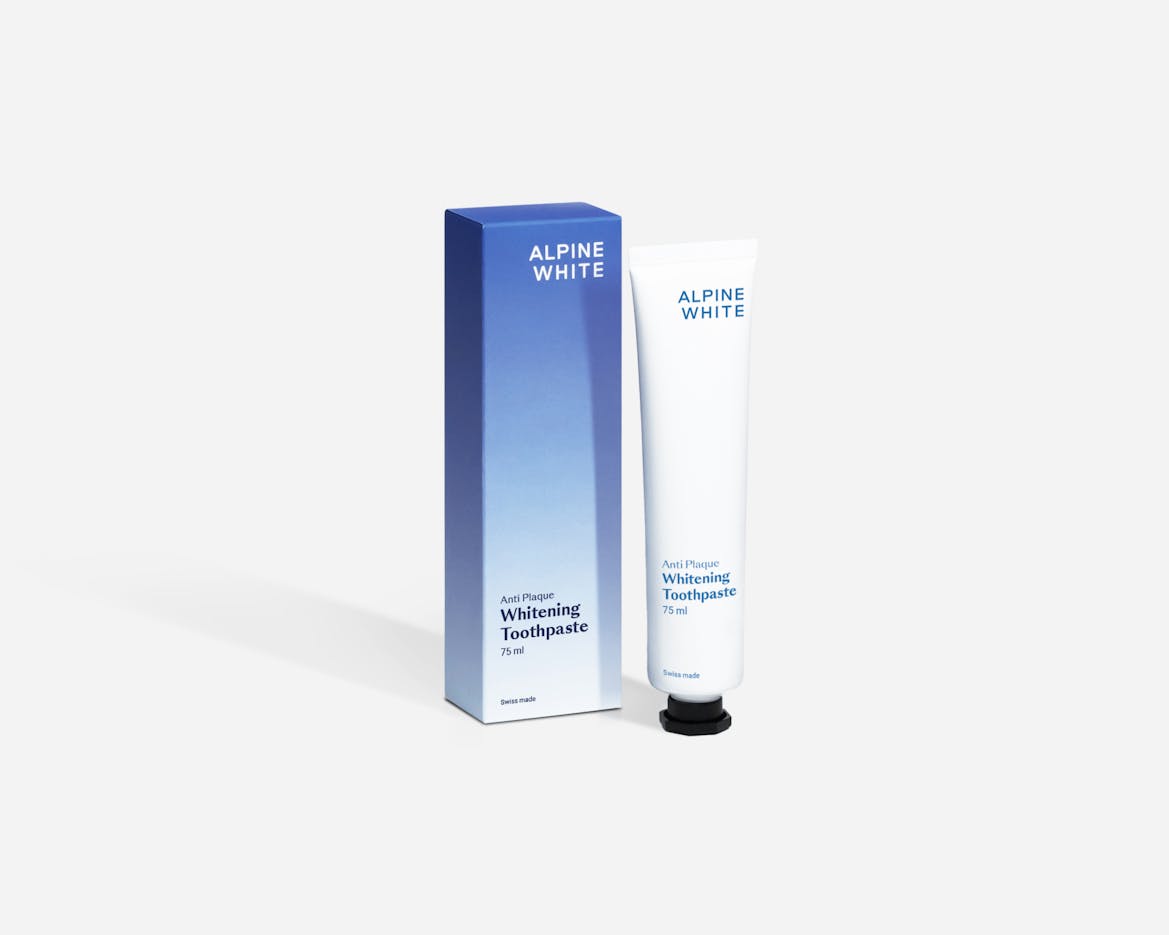

Your solution for stubborn plaque. Whitening Toothpaste Anti Plaque is designed to remove plaque and whiten teeth at the same time. For daily gentle dental and oral hygiene.
- Removes stubborn stains and tartar
- Based on our clinically tested Whitening formulation
- Remineralizes the enamel and relieves existing tooth sensitivity
- Antioxidants for healthy gums
- ormulated and produced in Switzerland
Frequently asked questions
- Why is it important to use toothpaste?
Toothpaste is essential for oral health because it helps to remove plaque and bacteria from the teeth and gums. It contains ingredients like fluoride, which strengthens tooth enamel and helps prevent tooth decay and cavities.
- How much toothpaste should I use?
For adults, a pea-sized amount of toothpaste is recommended. For children under the age of 3, a smear the size of a rice grain is advised, and for children aged 3-6, a pea-sized amount is appropriate.
- How often should I brush my teeth?
It is recommended to brush your teeth twice a day: once in the morning and once before going to bed at night. This helps to prevent tooth decay, gum disease, and bad breath.
- Can toothpaste expire?
Yes, toothpaste can expire. The expiration date is usually printed on the packaging. Expired toothpaste may not be as effective in preventing tooth decay and freshening breath.
- Is fluoride in toothpaste safe?
Yes, fluoride in toothpaste is safe and beneficial for most people when used as directed. It helps to prevent cavities and can reverse early tooth decay. However, swallowing large amounts of fluoride over time can cause health issues, so it's important to use it as intended.
Wrapping up
Here's the deal: we all care about our teeth, and the world of toothpaste is bigger and more interesting than you might think.
At ALPINE WHITE, we're really proud of our Whitening Toothpaste. It's made with a lot of care in Switzerland to make sure you can get a whiter smile without harming your teeth. People seem to love it – they're telling us it works wonders.
As everything around us keeps changing, including the toothpaste we use, we promise to keep making a product that you can trust and feel good about. So, give your teeth the attention they deserve with ALPINE WHITE, and let's keep those smiles bright together.
Sources
- “Usage of toothpaste in the U.S. 2011-2024” (2024), Statista, [available at https://www.statista.com/statistics/287376/usage-of-toothpaste-in-the-us-trend/].
- “Toothpaste - Global Strategic Business Report,” (2024) Research and Markets ltd, [available at https://www.researchandmarkets.com/reports/354898/toothpaste_global_strategic_business_report?utm_source=BW&utm_medium=PressRelease&utm_code=rm7g5m&utm_campaign=1437813+-+Global+Toothpaste+Market+Trajectory+%26+Analytics+Report+2020%3a+Covid-19+has+Doubled+the+Emphasis+on+Oral+Hygiene&utm_exec=chdo54prd].
- “Leading toothpaste vendors in the U.S. 2021, based on sales” (2023), Statista, [available at https://www.statista.com/statistics/195642/leading-us-toothpaste-vendors-in-2007-and-2008-based-on-sales/].
- “Average daily usage of toothpaste in the U.S. 2020” (2024), Statista, [available at https://www.statista.com/statistics/278187/us-households-average-daily-usage-of-toothpaste/].
- “Brands of toothpaste used in the U.S. 2013-2020” (2024), Statista, [available at https://www.statista.com/statistics/319740/brands-of-toothpaste-in-the-us-trend/].
- “Toothpaste - Market Share Analysis, Industry Trends & Statistics, Growth Forecasts 2019 - 2029,” (2024) Research and Markets Ltd, [available at https://www.researchandmarkets.com/reports/4622360/toothpaste-market-share-analysis-industry].
- “Toothpaste usage in Great Britain 2020, by type” (2023), Statista, [available at https://www.statista.com/statistics/303643/toopaste-usage-by-type-in-the-uk/].
- H. Naccache, P.L. Simard, L. Trahan, M. Demers, C. Lapointe, J.-M. Brodeur; Variability in the Ingestion of Toothpaste by Preschool Children. Caries Res 1 May 1990; 24 (5): 359–363. [available at https://doi.org/10.1159/000261296].
- “OTC revenue of toothpaste in the U.S. 2011-2022” (2023), Statista, [available at https://www.statista.com/statistics/506617/otc-revenue-of-toothpaste-in-the-us/].
- Datta, Y., “The U.S. Toothpaste Market: A Competitive Profile,” (2020) Datta | Journal of Economics and Public Finance, [available at http://www.scholink.org/ojs/index.php/jepf/article/view/2644/2711].
- De Menezes, Valdenice Aparecida, Rachel Pollyana Falcão Lorena, Liliane Cristina Barbosa Rocha, Angéllica Falcão Leite, Jainara Maria Soares Ferreira, and Ana Flávia Granville‐Garcia , “Oral hygiene practices, dental service use and oral health self-perception of schoolchildren from a rural zone in the Brazilian Northeast region,” (2010) Revista odonto ciência, [available at https://www.scielo.br/j/roc/a/YNdbbrNK3K5kFBSFZbbjcKr/?lang=en].
- “Latin America: toothpaste per capita consumption volume 2017” (2024), Statista, [available at https://www.statista.com/statistics/986067/toothpaste-per-capita-consumption-volume-latin-america/].
- “U.S. toothpaste sales via different sales channels 2011/2012” (2024), Statista, [available at https://www.statista.com/statistics/192660/us-toothpaste-sales-via-different-sales-channels-in-2010-and-2011/].
- “Latin America: import value of oral and dental hygiene products 2022, by country” (2024), Statista, [available at https://www.statista.com/statistics/917501/latin-america-dental-care-products-imports-value-country/].
- Gomez-Berrada, Marie-Pierre, Anne‐Sophie Ficheux, Inès Boudières, Myriam Chiter, Aurélie Rielland, Dominique Javel, Alain‐Claude Roudot, and Pierre–Jacques Ferret, “Consumption and exposure assessment to toothpaste in French families,” (2018) Food and chemical toxicology, [available at https://www.sciencedirect.com/science/article/abs/pii/S0278691518302849?via%3Dihub].
- Gkekas, Athanasios, Benoît Varenne, Nicole Stauf, Habib Benzian, and Stefan Listl, “Affordability of essential medicines: The case of fluoride toothpaste in 78 countries,” (2022) PloS one, [available at https://www.semanticscholar.org/reader/2a0f531e4440634d6f1f1310089a4a01f2fac83e].
- Nishikawara, Fusao, Yasuo Nomura, Yoh Tamaki, Seiko Katsumura, Yoshinobu Asada, and Nobuhiro Hanada, “Fluoride-containing toothpastes available in two European countries,” (2006) Pediatric Dental Journal, [available at https://www.sciencedirect.com/science/article/abs/pii/S0917239406700866?via%3Dihub].
- Goldman, Ann S., Robert Yee, Christopher J. Holmgren, and Habib Benzian, “Global affordability of fluoride toothpaste,” (2008) Globalization and Health, [available at https://globalizationandhealth.biomedcentral.com/articles/10.1186/1744-8603-4-7].
